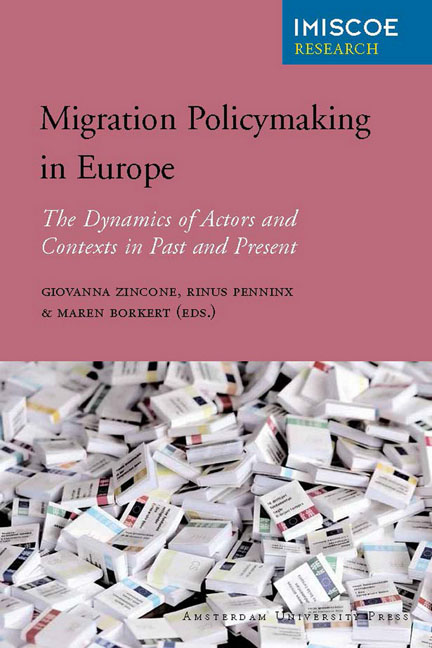Book contents
- Frontmatter
- Contents
- Policymaking in the Field of Migration and Integration in Europe: An Introduction
- Part I Post-War Migration Countries
- Part II Mediterranean Migration Countries
- Part III Eastern European Countries
- Conclusion: Comparing the Making of Migration Policies
- List of Contributors
- Other IMISCOE Titles
9 - The Case of the Czech Republic
Published online by Cambridge University Press: 20 January 2021
- Frontmatter
- Contents
- Policymaking in the Field of Migration and Integration in Europe: An Introduction
- Part I Post-War Migration Countries
- Part II Mediterranean Migration Countries
- Part III Eastern European Countries
- Conclusion: Comparing the Making of Migration Policies
- List of Contributors
- Other IMISCOE Titles
Summary
Introduction
The area that now constitutes the Czech Republic was, over the last centuries, characterised more by the phenomenon of emigration than by processes of immigration. Between 1850 and 1914, the territory of the Czech Lands experienced a net emigration of about 1.6 million inhabitants (Drbohlav 2004). The Czech Lands came to be characterised by more substantial immigration at the end of the twentieth century with the exception of return migration after 1918 and 1945. Before then, Czech emigration was mainly directed to other parts of the Austro-Hungarian Empire, as well as to the United States and Canada. Migrants’ main motivates were to seek work and a better quality of life. While these socio-economic factors were crucial for Czech emigration history before World War II, the situation changed at the end of the 1930s. At that time, political factors were gaining significance, causing mass migration movements across the whole of Europe. After phases of emigration and immigration among displaced persons, the post-war period was characterised by expulsions. Between 1945 and 1946, in response to World War II, nearly the entire German minority of Czechoslovakia – comprising about 2.7 million people – was exiled to Germany and Austria. These movements led to both planned and unplanned migration that would repopulate the area and provide workers for the national economy (e.g. in heavy industry, agriculture and forestry). Furthermore, it transformed the Czech part of Czechoslovakia into a fairly homogenous society in terms of ethnic groups: 94 per cent of the population at that time was Czech.
During the Communist era, during which some 420,000 to 440,000 people left the country between 1948 and 1990, some immigration occurred. This flow was mainly facilitated by agreements regarding temporary workers, drawn up with other socialist countries such as Poland and Hungary. These ‘guest workers’ were hired under so-called ‘international aid cooperation’ (Boušková 1998; Drbohlav 2004). Apart from agreements with neighbouring countries, bilateral agreements were signed throughout the 1970s and 1980s with more distant places, such as Vietnam, Mongolia, Angola, North Korea, the Republic of Cyprus, Laos and Cuba. This migration scheme was strictly regulated and involved workers, interns and students (Boušková 1998).
- Type
- Chapter
- Information
- Migration Policymaking in EuropeThe Dynamics of Actors and Contexts in Past and Present, pp. 327 - 346Publisher: Amsterdam University PressPrint publication year: 2012



